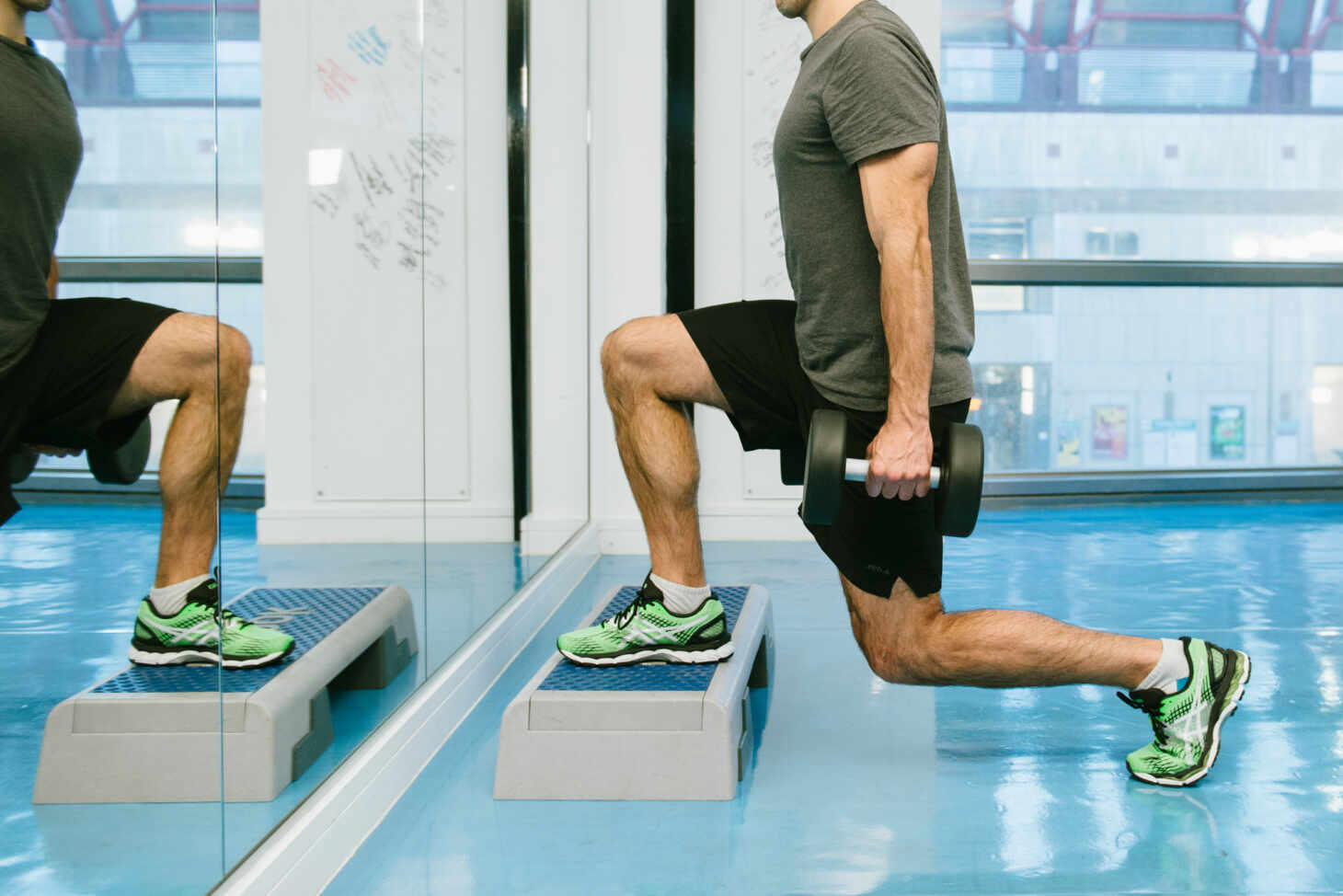Essential Stretching Tips for Endurance Runners

Pure Sports Medicine
- 7 November, 2022
- Running
- 5 min read
The status quo bias tells us that we continue to do something, because we’ve always done it – it’s what we’ve always known – and over the years this has seemed to have applied to running, and specifically, endurance runners.

Stretching techniques vary from static to dynamic, PNF and ballistic, and the first two are often incorporated into a warm-up, and/or cool down routine for athletes. Endurance runners are considered to include anyone who runs a distance of over 5KM, and performance potential is usually dictated by physiological parameters such as VO2 max and lactate threshold, and running efficiency, which includes muscle morphology, elastic potential of tendons, and joint mechanics.
Static Stretching
Static stretching is commonly performed by holding a muscle under tension for a period of time, usually around 30 seconds – it has been shown that holding a stretch for any longer does not necessarily have any further benefit.
Consistent stretching, over a period of six weeks, has been shown to improve overall flexibility, however static stretching immediately prior to exercise can actually inhibit performance, especially in short, explosive tasks such as sprinting or track sessions. It can be inhibited due to the physiological changes seen in the muscle and the decreased ability to store elastic energy from static stretching.
Furthermore, stretching can acutely strain a muscle, causing a decrease in force development and an increase in oxygen requirement for the hour following the stretching regime, possibly leading to injury.
Dynamic Stretching
Dynamic stretching, which can include plyometric movements, has been shown to improve running performance, with respect to the stretch-shortening cycle (SSC).
The stretch-shortening cycle is where an active muscle lengthening (stretch) is followed immediately by an active muscle shortening – this is essentially what allows us to run.
Using plyometric exercises such as bounding, hopping, and jumping, exaggerates the stretch-shortening cycle, and has been shown over a longer-term period, the effects can be seen as quick as 6 weeks into a program.
It also leads to a significant improvement in running economy in elite runners. Improvements in running economy from the warmup have been shown to result in superior running performance, due to a reduced energy cost at submaximal intensities.
There is even evidence to suggest that those athletes with superior running economy can compensate for limitations in VO2 max when compared with other athletes. The use of dynamic stretches within a warmup, which utilise this stretch-shortening cycle, has also been shown to elevate VO2 the same as when compared to a 15-minute gentle run for a warmup. The aim of a warmup is to elevate VO2 (your body’s ability to transport and use oxygen whilst performing aerobic exercise such as running), as well as mobilise the muscles in preparation for the task ahead.
It is hypothesised in research that stiffer muscles at the ankle and knee joints provide the best running economy, due to an increase in force potential when transitioning through stance phase.
Inflexibility at the calf and hip regions are associated with improved running economy as less energy is required for postural/muscular stabilisation. Static stretching reduces the stiffness and therefore may compromise running economy.
Stretching to Prevent Injury
Chronic overuse injuries are frequent and devastating for long distance athletes. Common running related injuries include medial tibial stress syndrome (shin splints), plantar fasciitis, Achilles’ tendonitis, stress fractures and various knee related injuries. Stretching has been considered a tool for reducing the risk of injury for endurance athletes and is an additional reason stretching is often used by endurance runners.
The research promoting stretching as part of a routine, not performed directly before running, is focused on shorter distance runners, and shows a potential increase in the compliance of the musculotendinous unit which may allow for greater force production at longer muscle lengths. However, this is not applicable to an endurance runner because you do not perform at long enough muscle lengths to achieve the benefits. This is why endurance athletes are less likely to encounter muscle strain injuries compared to more explosive sports such as sprinting.
There may be an optimal level of flexibility, however genetics play a part in this so some of it is likely out of our control. The gene COL581 is associated with inflexibility and has been shown to be more prevalent in endurance runners compared to the general population, further suggesting inflexibility is a favourable trait for endurance runners.
With regards to DOMS (Delayed Onset Muscle Soreness), there is no evidence which suggests that stretching, either as part of a daily routine, or as part of a warm-up, has the ability to reduce either the presence of DOMS, or the prevalence of chronic injury in long distance runners. DOMS is usually triggered by a series of biochemical changes that occur as a result of muscle damage, when individuals are exposed to high force eccentric contractions repeatedly and/or unaccustomed exercise – running down hills, or high intensity running, is a common precursor for DOMS in runners.
One study (Yamaguchi et al, 2020), found a warm-up consisting of 4-5 minutes of dynamic stretches to be more effective than a 15-minute zone 2 effort, on performance. Their warm-up protocol consisted of:
- leg swings
- knee to chest
- butt kicks
- holding the thigh parallel to the floor and extending the knee straight out in front of you
- heel raises into toe raises
- x10 repetitions of each exercise were performed as quickly as possible
To conclude, dynamic stretching has been found to be as good, and in some cases, better than a steady jog, as a warm-up prior to running.
It is important to note that plyometric exercises, such as jumping, bounding, and hopping, are useful to boost running economy, prior to faster sessions of running, such as a track session. But be careful not to overdo it, too much can result in a deterioration in performance due to an increase in fatigue.
The whole concept of stretching to improve flexibility in endurance runners may not be as beneficial as once thought stiffness in the lower limb is associated with increased running economy.
Another way to improve stiffness is to incorporate strength training into your routine. This has been shown to increase running economy. A base range of flexibility will neither improve nor decrease the likeliness of developing running related injuries, however extreme cases outside the normal range of flexibility might be problematic. If in doubt, seek advice from a qualified healthcare professional with experience seeing runners.
A typical active warm-up for a long-distance runner could look something like this:
- Start with 5–10min of walking or easy jogging
- If preparing for a fast-running effort, training session or race, then incorporate 6–8 dynamic movement drills with particular focus on the lower limbs:
-
- walking lunges
- side lunges with thoracic twist
- leg swings
- A skips
- walking single leg dead lifts
- heel to bum kicks
- Pogos or fast feet
- Conclude the warm-up by completing three short building sprint efforts.
REFERENCES:
- Alexander, James LN, Christian J. Barton, and Richard W. Willy. “Infographic running myth: static stretching reduces injury risk in runners.” British Journal of Sports Medicine 54.17 (2020): 1058-1059.
- Bailey et al, 2009. Optimizing the “priming” effect: influence of prior exercise intensity and recovery duration on O2 uptake kinetics and severe intensity exercise tolerance. Journal of Applied Physiology. 107: 1743 – 1756
- Baxter, Claire, et al. “Impact of stretching on the performance and injury risk of long-distance runners.” Research in Sports Medicine 25.1 (2017): 78-90.
- Blagrove, Richard C., et al. “Efficacy of depth jumps to elicit a post-activation performance enhancement in junior endurance runners.” Journal of science and medicine in sport 22.2 (2019): 239-244.
- Pappas et al, 2017. Acute effects of stretching on leg vertical stiffness during treadmill running. Journal of Strength and Conditioning Research. 31: 3417 – 3424
- Yamaguchi, Taichi, et al. “Acute effect of dynamic stretching or running on endurance running performance in well-trained male runners.” Gazzetta Medica Italiana Archivio per le Scienze Mediche 179 (2020): 13-19.

Advice
Over the last 20+ years our experts have helped more than 100,000 patients, but we don’t stop there. We also like to share our knowledge and insight to help people lead healthier lives, and here you will find our extensive library of advice on a variety of topics to help you do the same.
OUR ADVICE HUBS See all Advice Hubs

